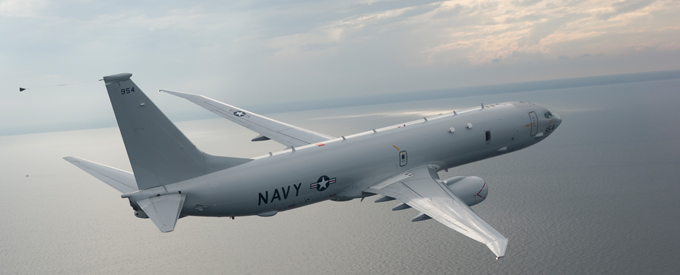2019-12-05
Australia’s P-8A Fleet Nears Full Capacity
Now approaching full operating capacity, 10 of Australia’s fleet of 12 P-8A Poseidon maritime surveillance aircraft are located at Royal Australian Air Force (RAAF) Base Edinburgh in South Australia. The final RAAF surveillance aircraft are expected to arrive at Edinburgh in the north of Adelaide early next year.
With anti-submarine warfare and maritime strike capabilities, the P-8As have already been used for Australian border protection surveillance (Operation Resolute), joining a multinational effort to monitor maritime cargo movement into North Korea (Operation Argos) and supporting international promotion of Middle East maritime security (Operation Manitou).
Boeing uses a first-in-industry in-line production system for the P-8, leveraging the best of Boeing Commercial and Boeing Defence for development and production. Flying up to 41,000 feet at 490 knots, this 737 model has a 99.8 per cent dispatch rate, with more than 4,000 aircraft flying and 6,600+ orders.
The P-8 is engineered for 25 years or 25,000 hours in the harshest maritime flight regimes, including extended operations in icing environments. Suitable for every flight regime required, it self-deploys up to 4,500 miles from base without refuelling.
The dual CFM-56B commercial engines are each equipped with a 180KVA engine driven generator to provide 27,000 pounds of thrust, greatly enhancing climb and flight characteristics over turboprop equipped aircraft. Combined with the 90KVA commercial APU, this provides the P-8 with 450KVA of power.
Possessing significant equipment growth capacity with excess onboard power and cooling capacity, the P-8 has twice the normal sonobuoy processing. It can carry 30 per cent more sonobuoys than any maritime patrol and reconnaissance aircraft currently flying.
Moreover, the P-8 has the ability to control unmanned air vehicles (level 2 control-receive) to extend sensor reach. P-8s offer commonality with 737 fleet and other military platforms using the 737 airframe.
Ambitious Australian P-8 Programme
The 2016 Australian Defence White Paper flagged 15 new Poseidon P8-As, with the Australian Government committing to 12 so far. The White Paper also targeted seven unmanned MQ-4C Triton aircraft to complement the P8-A on border patrol and maritime surveillance.
With two of an initial six of the unmanned Tritons having been approved for first delivery in 2023, RAAF Director of Intelligence, Surveillance, Reconnaissance, Electronic Warfare and Space Group Captain, Jason Lind said he expected all 12 P-8As to be stationed at Edinburgh by March 2020. Indeed, the Boeing-built aircraft have exceeded expectations since the first P-8A was delivered in late 2016.
“Because they’ve been so effective, they have been deployed ahead of final operational capability, which can put a bit of a stress on the people operating them,” Group Captain Lind confirmed. “But certainly they’ve been doing a really good job up north in border protection. They’ve also been deployed in Japan enforcing the embargo on North Korea and one has even gone over to the Middle East supporting a U.S. initiative patrolling the Gulf.”
The 5th-generation Poseidon and Triton maritime patrol and response programme falls under the operational command of 92 Wing, based at Edinburgh, South Australia, while eight Australian Defence Force personnel are working with the U.S. Navy in the Joint Program Office developing Triton, which is currently undergoing test flights. Overall, there are about 40 personnel on the Triton project with the operational unit expected to grow to 140 upon delivery of the unmanned aircraft.
Group Captain Lind confirmed that the remote pilots would be at Edinburgh. It is yet to be decided whether the Triton Unmanned Aerial Systems would be physically based at Edinburgh or Tindal Air Base in the Northern Territory,
“These 5th generation type aircraft provide more opportunity to move people between the platforms than we have done previously, so having the preponderance of people there in Edinburgh is a good way to get synergies from our workforce,” Captain Lind concluded. “Triton, which flies at 50,000 feet plus, can give you great perspective and endurance and the P-8 can be more responsive to what the Triton might see – certainly they are designed to work together.”
The P-8A aircraft and MQ-4C Triton will replace the AP-3C Orions, which are due for withdrawal this year following more than 50 years of RAAF service.
The Edinburgh Defence Precinct is home to 3,500 RAAF and Australian Army personnel, Defence Science and Technology, and key defence primes including BAE Systems, Raytheon Australia and Airbus Group Australia Pacific.
South Australia is also pivotal in Australia’s $90 billion plan to regenerate the Royal Australian Navy with new submarines, frigates and offshore patrol vessels. The Attack Class submarines will be built at the Osborne Naval Shipyard in Adelaide, which is undergoing a AUD500 million upgrade.
The state also has a strong link with space. Late last year Adelaide was announced as the home of the Australian Space Agency, to which a $6 million Mission Control centre for small satellites and an educational space discovery centre has since been added.
The United States Navy and the Royal Australian Air Force currently fly the P-8A Poseidon variant; the Indian Navy flies the P-8I variant. The United Kingdom and Norway have also selected the P-8A as their future maritime patrol aircraft.
Reference Text/photo:


No Comments